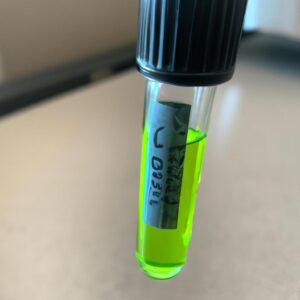Gene therapy is a type of medical treatment that involves using genetic material to address health issues. By introducing new genes into a person’s cells, it can help to replace, modify or turn off the genes that cause rare diseases. In recent years, gene therapy has been successfully used to treat a variety of conditions, including some rare diseases, offering hope to individuals who may not have had any other options for treatment.
This guide will provide a comprehensive overview of how gene therapy is being used to combat rare diseases. We’ll start by discussing the current treatments available for these diseases and then give an in-depth explanation of gene therapy, including its origin and the types of treatments available. We’ll also explain the potential benefits of using gene therapy to treat rare diseases, as well as any risks associated with it. We’ll provide examples of how gene therapy is currently being used to treat rare diseases and explore potential future applications of the technology. Finally, we’ll offer links to additional resources and a brief conclusion.
The treatment of rare diseases can be a challenging task as the symptoms and severity of each condition varies for each individual. In general, current treatments focus on managing the symptoms of a rare disease while exploring ways to slow down its progression. Depending on the nature of the disease, methods such as physical or occupational therapy, dietary modifications, medication, gene therapy, and/or surgery may be recommended.
Drug therapy is used to treat the symptoms of many rare diseases. For example, drugs that reduce inflammation or modify the activity of the immune system are often used to treat autoimmune diseases. Dietary changes or supplements may be used to address nutrient deficiencies or metabolic disorders.
Gene therapy has become increasingly more common as a potential treatment for rare diseases. It involves introducing new genetic material into cells in order to replace, repair, or supplement a defective gene. This can be done by using vectors such as viruses or other harmless particles to transfer DNA into an individual’s cells. Gene therapy has been used to combat a wide range of conditions including genetic blood disorders, certain cancers, HIV/AIDS, and some inherited ocular diseases.
In addition to drug and gene therapies, surgical interventions may also be used to treat rare diseases. For example, bone marrow transplants may be used to treat certain types of leukemia, and heart valve replacement may be performed for some congenital cardiac defects.
Overall, the best treatment approach for rare diseases will vary depending on the condition and the individual’s unique case. Healthcare professionals work closely with patients and their families to develop the most effective treatment plan based on their specific needs.
Gene therapy is a medical treatment that involves the use of genetic material to treat a medical condition. It has been used to combat a range of diseases, from cancer to rare genetic diseases. At its core, gene therapy involves introducing genetic material into a person’s cells to alter their genetic make-up and potentially induce a cure. This method has the potential to be used to treat a range of rare diseases.
The origins of gene therapy can be traced back to the 1930s, when scientists first started to explore the idea of using genes to control diseases. It was not until the 1970s, however, that gene therapy began to take shape and researchers started to carry out experiments in this field. Today, there is a wide variety of gene therapies available, with different techniques being used for different types of diseases.
The most common type of gene therapy is somatic cell gene therapy. In this method, genetic material is inserted into a patient’s cells to replace a gene that is defective or missing. This new genetic material is typically delivered via a virus, which carries the new genetic material into the target cell. Another type of gene therapy is germline gene therapy, where genetic material is inserted into reproductive cells, such as egg and sperm cells, to create an offspring that is born with a genetic alteration.
Gene therapy has the potential to improve treatment options for individuals with rare diseases. Depending on the particular disease, gene therapy may be able to replace faulty or missing genes that are causing the condition, helping to restore normal function. Additionally, some gene therapies are used to boost the body’s natural immune system, which can help to fight off diseases like cancer.
The advantages of gene therapy are clear, but there are also potential risks. One of the main concerns is the possibility of unintended changes in the genetic material, which could lead to unexpected or harmful consequences. Additionally, there may be other risks, depending on the particular method and type of gene therapy being used.
It is important to consider both the potential benefits and risks of gene therapy before making any decisions. The only way to know if it could be a viable treatment option is to carefully assess the individual circumstances and consult with a medical professional.
Gene therapy has had many successes in treating rare diseases, and it is becoming increasingly popular for its potential benefits. Some of these benefits include more targeted treatments with fewer side effects, improved patient outcomes, and even the potential to cure certain diseases.
Gene therapy can be used to directly treat a genetic defect or boost the efficiency of existing treatments, such as introducing new genes to help fight off infections or enhance defective cells. Gene therapy also gives patients the potential for long-lasting or even permanent effects from the treatment, depending on the illness or disorder.
By targeting the underlying genetic causes of rare diseases, gene therapy has the potential to reduce or even eliminate the need for ongoing treatments or medications. Patients may even experience improved quality of life following gene therapy, as they no longer have to live with the symptoms and limitations caused by their illness.
In addition, gene therapy can eliminate the need for expensive surgeries or other treatments. Because gene therapy can often be done quickly and without extensive hospital stays, it can be a cost-effective option for patients.
Finally, gene therapy can even have the potential to cure certain diseases, depending on the type and severity. While not all illnesses are curable, gene therapy could potentially offer a long-term solution to some diseases.
These potential benefits make gene therapy a promising option for the treatment of rare diseases. As the technology advances, more people will likely benefit from its use in the future.
Gene therapy is a relatively new area of medicine which offers the potential for treating rare diseases, but there are still risks associated with using it. Although these risks can be minimized, it’s important to understand them before pursuing this form of treatment.
The biggest risk associated with gene therapy is the possibility of adverse reactions in patients receiving the treatment. This could include serious side effects or an immune system response to the genes being inserted. There is also a risk that the inserted genes may not work correctly, or may cause unexpected changes in the body.
There is also a risk of transferring genetic material to other parts of the body or to future generations. If this occurs, it could lead to unprotected exposure to the altered gene, which could result in unknown consequences.
To help reduce the risk of adverse reactions or unintended consequences, gene therapy must be conducted within an ethical framework. This includes carefully screening subjects and monitoring their progress before, during, and after treatment. It is essential that researchers have the necessary permission from regulatory bodies before conducting any gene therapy trials.
In addition, careful consideration needs to be given to the type of gene being used. Researchers should choose genes that have been successfully tested in laboratory settings and which have shown no signs of dangerous side effects.
While gene therapy carries some risks, it also has the potential to revolutionize how rare diseases are treated. By understanding the risks and taking all reasonable precautions, it is hoped that gene therapy will help develop treatments for some of the world’s rarest and most debilitating diseases.
Gene therapy has emerged as a promising way for treating rare diseases. In gene therapy, healthy genes are used to replace or supplement the function of defective genes in patients. This can help correct a genetic disorder, or reduce its symptoms.
Currently, gene therapy is being used to treat a number of rare diseases, such as cystic fibrosis, muscular dystrophy, hemophilia and some forms of cancer. It is also being studied as a treatment for other rare conditions, though these studies are still in early stages.
For example, researchers have been exploring ways to use gene therapy to target Huntington’s Disease. In a small study conducted in 2019, scientists attempted to deliver healthy copies of the mutant huntingtin gene into cells via adeno-associated viral vectors. While this initial trial was not successful, the potential for this form of gene therapy to treat Huntington’s Disease in the future remains promising.
In addition, research is being conducted to see if gene therapy could be used to treat rare blood disorders such as sickle cell anemia. Although the treatments are still in the early stages, scientists have already had success using gene therapy to restore normal red blood cell production in mouse models.
Gene therapy is also being studied as a potential treatment for other rare diseases such as mitochondrial myopathies and Charcot-Marie-Tooth disease. Although further research is needed to develop effective treatments for these conditions, the potential for gene therapy to be used in the future is very exciting.
Gene therapy has the potential to revolutionize the way rare diseases are treated. By utilizing gene therapy to directly target and change defective genes, more effective treatments can be created that will improve the quality of life for those suffering from rare diseases. Although there is still much research to be done, advancements in technology have enabled us to understand the potential for gene therapy to treat rare diseases. With the right combination of precautionary steps and further research, gene therapy could become an essential part of the treatment landscape for rare diseases.
To gain a better understanding of gene therapy and its potential to treat rare diseases, it is important to look at the resources and material available online. There are a number of websites and papers that discuss the use of gene therapy and its applications in treating rare diseases.
One of the top sources of information on gene therapy is the American Society of Gene & Cell Therapy, which provides an extensive range of resources including publications, videos and patient stories. Additionally, there are several clinical trials currently underway, some of which are listed on the ClinicalTrials.gov website. These trials can provide valuable insights into the effectiveness of gene therapy in treating rare diseases.
Other useful sources of information include the National Institutes of Health’s Genetic and Rare Diseases Information Center, which has a comprehensive database of information on rare diseases as well as links to resources. Additionally, the World Health Organization’s Global Strategy for Rare Diseases offers an easily accessible overview of the most current global strategies and resources relating to rare diseases.
For those new to the topic, there are also a number of introductory articles available online. For example, the Genetics Home Reference website has a selection of easy-to-understand articles on gene therapy and how it works. Additionally, the U.S. National Library of Medicine’s MedlinePlus website has a range of information articles covering the various aspects of gene therapy and its potential to treat rare diseases.
These resources can provide readers with a comprehensive understanding of gene therapy and its potential applications in treating rare diseases.
It is always important to make sure that any sources used in a blog post are cited correctly. When writing about gene therapy, it is crucial to cite documents and websites that provide accurate and up-to-date information about the latest developments in this field. Citing sources is essential for anyone researching and studying gene therapy as it allows readers to verify the accuracy of the information provided.
The appropriate way to cite sources will depend on the style guide being used, but usually consists of including the author’s name, year of publication, title of the document and the URL or DOI. For example:
Egan, A. (2020). How gene therapy treats rare diseases. Scientific American. www.scientificamerican.com/article/how-gene-therapy-treats-rare-diseases/
It is also important to be aware of copyright infringement and not use images or videos unless you have permission from the creator. Make sure attribution is given to any material that is used and all sources are properly credited throughout the post.
Images and videos can be powerful tools when it comes to understanding gene therapy and its implications. Images of gene sequences or cells can help visualize the physical changes that occur during a gene therapy treatment, while videos can capture the process in action. Visuals can provide an engaging way to learn about gene therapy and can be used to explain complex concepts and ideas.
When selecting visuals, make sure they are clear, concise and relevant to the topic. Aim for images and videos that are easy to understand and help to illustrate the points you are making. Provide captions or descriptions along with your images and videos to ensure readers can understand them in context. Additionally, make sure any materials used are properly credited and cited.
SEO optimization is an important step to ensure the success of a blog post. To optimize for search engines, it is essential to strategically place target search terms throughout the blog post. This can be done by incorporating key words into headings, subheadings, and paragraph text. Additionally, it is important to use accurate HTML tags such as
and
to properly structure and format the content for better readability. Finally, when applicable, it is helpful to use unordered lists, marked with
- and
- tags, to break up information into smaller chunks.
Promoting your guide on social media platforms and relevant forums can be a great way to spread awareness of the potential of gene therapy to treat rare diseases. Having a link to the post on these platforms will help you reach a larger audience and get more people interested in the topic. Additionally, you should make sure to include keywords that are related to your post in order to increase visibility in search engine results. Furthermore, you should consider tagging any relevant people or organizations who may be interested in this topic, as well as hashtags related to gene therapy, rare diseases, or other related topics. Doing so will increase the chances of reaching the right people and getting your content shared.
comments: 0











